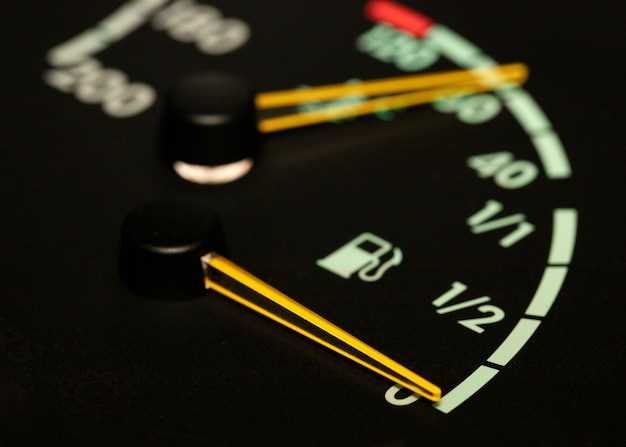
The heart of any performance car lies in its ability to deliver power efficiently, and at the core of this system is the fuel pump. A properly functioning fuel pump ensures that the engine receives the required amount of fuel to achieve peak performance. However, various factors can lead to fuel delivery problems, which can severely affect driving dynamics and overall performance. Detecting these issues early can save both time and money, preventing more extensive damage to the engine and other components.
One of the first symptoms of a fuel delivery problem is often a noticeable decrease in engine power or responsiveness. This can manifest as hesitation during acceleration or stalling under load. Common causes include a failing fuel pump, clogged fuel filters, or issues with fuel lines. Each of these components plays a vital role in ensuring that the correct amount of fuel reaches the engine at the right pressure.
To effectively diagnose these issues, car enthusiasts and mechanics must utilize a combination of visual inspections and diagnostic tools. Checking the integrity of the fuel pump, testing fuel pressure, and inspecting the fuel lines for leaks or blockages are essential steps in the troubleshooting process. Understanding how each part of the fuel delivery system interacts with the others can help in pinpointing the root cause of performance issues in high-performance vehicles.
Identifying Symptoms of Fuel Pump Failures
Recognizing the symptoms of fuel pump failures is crucial for maintaining the performance of high-performance vehicles. One of the most noticeable indicators is a decrease in engine power during acceleration. If the fuel pump is not delivering the necessary amount of fuel, the engine may struggle to reach higher RPMs, leading to sluggish performance.
Another common symptom is difficulty starting the engine. A failing fuel pump may not generate enough pressure to allow the engine to fire properly, resulting in prolonged cranking times or complete failure to start. Additionally, if the vehicle suddenly stalls while driving, it could indicate an insufficient fuel supply caused by pump issues.
Unusual noises coming from the fuel tank can also signal a failing fuel pump. When the pump is operating improperly, it may produce whining, buzzing, or grinding sounds. These noises are often a result of wear and tear inside the pump, indicating that replacement may be necessary.
Fuel pressure gauge readings can further assist in diagnosing issues. If the pressure is consistently low, it suggests that the fuel pump is not functioning effectively. Regular maintenance and monitoring of fuel pressure can help prevent further engine complications.
Lastly, unexpected fluctuations in fuel efficiency can indicate a failing pump. If a vehicle consumes more fuel than usual without changes in driving habits, it may be due to the fuel pump struggling to maintain adequate fuel flow. Identifying these symptoms early can help avoid critical failures and costly repairs in performance cars.
Testing Fuel Pressure and Flow Rate
To accurately diagnose fuel delivery problems in performance cars, testing fuel pressure and flow rate is essential. This process ensures that the fuel pump is functioning correctly and delivering the necessary amount of fuel for optimal engine performance.
Here are the steps to effectively test fuel pressure and flow rate:
- Gather Necessary Tools:
- Fuel pressure gauge
- Fuel flow meter (if available)
- Appropriate fuel line adaptors
- Safety goggles and gloves
- Prepare the Vehicle:
- Make sure the engine is turned off and cool.
- Relieve fuel system pressure by removing the fuel pump relay or fuse, then start the engine until it stalls.
- Connect the Fuel Pressure Gauge:
- Locate the fuel pressure test port, typically found on the fuel rail.
- Attach the fuel pressure gauge securely to the test port.
- Start the Engine:
- Reinstall the fuel pump relay or fuse.
- Start the engine and allow it to idle.
- Check Fuel Pressure:
- Read the pressure gauge. Compare the reading with the manufacturer’s specifications.
- Record the pressure to analyze if it’s within the acceptable range.
- Test Fuel Flow Rate (Optional):
- With the engine off, disconnect the fuel line and direct it into a container.
- Use a jumper wire to activate the fuel pump. Measure how much fuel is delivered in a set timeframe, typically per minute.
- Compare the flow rate with specifications to determine if the pump is sufficient.
- Analyze Results:
- Low fuel pressure may indicate a failing pump, clogged fuel filter, or leaking fuel lines.
- Inadequate flow rate can suggest pump malfunction or restrictions in the fuel system.
By carefully executing these steps, you can identify fuel delivery issues effectively and ensure your performance car runs at its best.
Inspecting Electrical Connections to the Fuel Pump

When diagnosing fuel delivery problems in performance cars, one crucial area to scrutinize is the electrical connections to the fuel pump. A reliable electrical system ensures that the fuel pump operates efficiently, delivering the necessary fuel to the injectors. Any faults in these connections can lead to inadequate fuel flow, affecting engine performance.
Begin by locating the fuel pump and its associated electrical connectors. Often, these connections are found under the rear seat or in the trunk area, depending on the vehicle’s design. Carefully inspect each connector for signs of corrosion, loose contacts, or damaged wires. Corrosion can impede electrical flow, while loose connections may cause intermittent failures.
Utilize a multimeter to test the voltage at the fuel pump connector. With the ignition turned on, you should observe a steady voltage reading consistent with the vehicle’s specifications. Insufficient voltage can indicate a problem in the wiring harness or a faulty relay. Additionally, check for any grounding issues, as a poor ground can lead to insufficient power reaching the fuel pump.
If any electrical issues are detected, repair or replace the damaged components. Ensure that all connections are secure and free of debris. After making these adjustments, perform additional tests to confirm that the fuel pump is functioning correctly and that fuel is being delivered properly to the injectors, ultimately restoring optimal engine performance.
Analyzing Injector Performance and Spray Patterns
Evaluating the performance of fuel injectors is essential for ensuring optimal combustion and overall efficiency in performance cars. Fuel injectors are responsible for delivering precise amounts of fuel into the combustion chamber, and any discrepancies in their operation can lead to a range of issues, including misfires, power loss, and increased emissions. Analyzing injector performance involves assessing the flow rate, atomization quality, and spray patterns.
To accurately analyze injector performance, it is crucial to measure several parameters. The following table summarizes the key factors that influence injector efficiency and their roles in maintaining optimal engine performance:
| Parameter | Description |
|---|---|
| Flow Rate | The amount of fuel delivered by the injector per unit of time, typically measured in cc/min. A consistent flow rate is essential for proper air-fuel mixture. |
| Spray Pattern | The shape and distribution of the fuel spray. A well-defined spray pattern enhances mixing with air, promoting efficient combustion. |
| Atomization | The size of fuel droplets emitted. Smaller droplets improve vaporization and combustion efficiency. |
| Response Time | The speed at which the injector opens and closes, affecting the precision of fuel delivery during rapid throttle changes. |
| Leakage | Unintentional fuel flow when the injector is closed. Leakage can result in rich mixtures and increased emissions. |
When analyzing spray patterns, utilizing a specialized flow testing setup allows for visual observation of injector operation under various pressure conditions. This examination helps in identifying irregularities that could indicate wear or internal fouling. Understanding how the injector spray interacts with the intake air is also critical; ideally, the fuel should mix thoroughly to achieve the best possible combustion.
In addition to visual analysis, using diagnostic tools and software can help quantify injector performance accurately. Parameters like duty cycle, pulse width, and the interaction between the fuel pump and injectors should also be evaluated, as an insufficient fuel supply from the pump can adversely affect injector performance. Ultimately, a thorough understanding of injector behavior is key to diagnosing and rectifying fuel delivery issues in performance vehicles.
Detecting Fuel Leaks in the System
Identifying fuel leaks within the fuel delivery system is crucial for maintaining optimal performance in high-powered vehicles. Fuel leaks can significantly affect engine efficiency, leading to unsafe driving conditions and potential damage to components. Several methods can be employed to detect these leaks effectively.
One of the simplest and most effective ways to locate fuel leaks is through a visual inspection. Begin by examining the fuel system components, including fuel lines, injectors, and connections. Look for signs of fuel saturation, drips, or staining around these areas. A strong smell of gasoline is often an indicator of a leak nearby.
Utilizing specialized tools can enhance leak detection accuracy. A fuel pressure gauge can be installed to monitor the pressure within the system. A persistent drop in pressure, even when the engine is off, implies a possible leak. Additionally, employing a smoke machine can help reveal leaks by introducing smoke into the system, allowing any escaping fuel vapor to be easily spotted.
Another common method involves using a fuel dye. Adding a non-toxic dye to the fuel can help trace leaks as the dyed fuel seeps out, providing a clear visual cue. This technique is particularly useful for diagnosing leaks in hard-to-reach areas or beneath the vehicle.
Lastly, pay attention to performance issues such as rough idling, decreased power, or increased fuel consumption, which can also signal fuel delivery problems. If these symptoms accompany any signs of a leak, further investigation is warranted. Ensuring a fully functional fuel system is essential for a performance car’s reliability and safety.
Using Diagnostic Tools for Fuel System Analysis

Effective diagnosis of fuel delivery problems in performance cars requires the integration of advanced diagnostic tools. These tools enable technicians to accurately assess the condition of the fuel system, ensuring efficient pump operation and optimal engine performance.
Here are some essential diagnostic tools used in fuel system analysis:
- Fuel Pressure Gauge: This tool measures the pressure within the fuel lines. By connecting it to the fuel rail, technicians can determine whether the fuel pump is delivering sufficient pressure. A reading below the specified range indicates a potential issue with the pump or fuel filter.
- Fuel Injector Tester: This device checks the functionality of individual fuel injectors. By simulating operational conditions, it can reveal issues such as clogged nozzles or inconsistent spray patterns, which can negatively impact fuel delivery.
- Scan Tool: An OBD-II (On-Board Diagnostics) scanner can identify error codes related to the fuel system. By analyzing these codes, technicians can pinpoint malfunctions associated with sensors that monitor fuel pressure and flow.
- Fuel Flow Meter: This tool measures the volume of fuel delivered by the pump over a specific period. It helps detect problems such as reduced flow rates that might suggest fuel system restrictions or pump inefficiency.
- Oscilloscope: Used to analyze electrical signals in the fuel system, the oscilloscope can visualize the performance of the fuel pump and injectors. This diagnostic tool helps in identifying issues related to electrical components, such as voltage drops or faulty connections.
When employing these diagnostic tools, follow these steps for a thorough analysis:
- Start with the fuel pressure gauge to establish baseline pressure readings.
- Use a scan tool to check for any error codes affecting the fuel delivery system.
- Test the injectors with a fuel injector tester to ensure they are functioning correctly.
- Measure fuel flow with a flow meter to confirm adequate delivery rates from the pump.
- Analyze the electrical characteristics of the fuel pump and injectors with an oscilloscope to identify any underlying electrical issues.
By systematically utilizing these diagnostic tools, mechanics can efficiently identify and resolve fuel delivery problems, ensuring that performance cars operate at their best.
